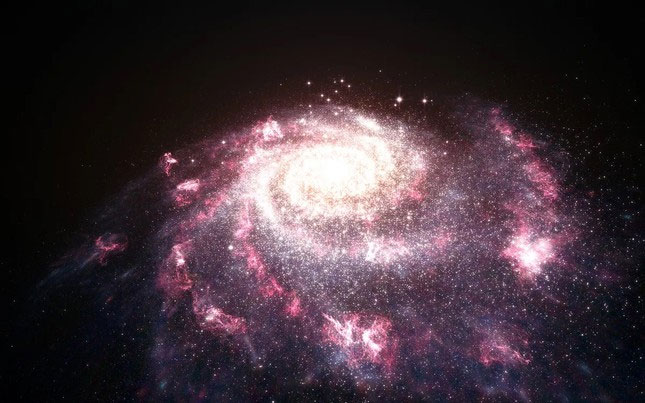James Webb Telescope Discovers a Mysterious Group of Galaxies?
Astrophysicists explain how the James Webb Telescope discovered a mysterious group of galaxies that threatens to disrupt cosmology.
The galaxies discovered by the James Webb Space Telescope (JWST) formed as early as 500 million years after the Big Bang, and are so bright that they theoretically should not have existed. The Milky Way, these early galaxies, formed in a very short time compared to our own.
The discovery threatens to overturn physicists' understanding of galaxy formation and even the standard model of cosmology.

This illustration shows a chaotic, disorderly galaxy undergoing bursts of star formation. (Image: ESA, NASA, L. Calçada)
Using supercomputer simulation
Now, a team of researchers using supercomputer simulations suggests the galaxies might not be that big – they might be unusually bright.
'Normally, a galaxy is bright because it is big. How could these massive galaxies have come together so quickly? Our simulations show that galaxies had no trouble forming this brightness at the cosmic dawn ,' said senior study author Claude-André Faucher-Giguère, an astrophysicist at Northwestern University.
Currently accepted theories suggest that these first protogalaxies reached adolescence 1 to 2 billion years into the life of the universe - forming into dwarf galaxies that began devouring each other to grow into galaxies like our own.
That's what made JWST's discovery of thousands of unusually bright early galaxies, some even resembling our own, a surprise to astronomers. It's a discovery that throws their most basic understanding of how the universe evolved into serious doubt.
To investigate what might have given these galaxies their strange sparkle, the researchers created a model of galaxy formation and ran it through a supercomputer – simulating the swirling, condensing gas of the early universe as it turned into stars, which in turn formed galaxies.
By carefully calculating the mass, energy, momentum, and chemical composition of the young universe, the researchers found that stars at this early time may have formed in sudden , rapid explosions after years of silence. Known as 'explosive star formation ,' this process is unlike the steady rate of star formation in the universe today and may explain why the early universe was so bright.
- Hundreds of distant galaxies seen through the James Webb . telescope
- Admire spectacular images of the universe through the James Webb telescope
- James Webb telescope reveals the truth about the planet from nowhere, where sand turns to clouds
- NASA finished assembling $ 9.7 billion telescope
- Spectacular set of images of galaxies and nebulae taken by James Webb telescope
- James Webb telescope completes final test, set to launch in October
- Unique images in the universe from the James Webb telescope
- NASA reversed the time of launching the James Webb space telescope until 2020
- Telescope James Webb will search for alien life
- NASA has postponed the world's most powerful space telescope
- The James Webb Space Telescope will be launched into orbit in October 2018
- NASA hides technology on telescopes looking backwards
 Van Allen's belt and evidence that the Apollo 11 mission to the Moon was myth
Van Allen's belt and evidence that the Apollo 11 mission to the Moon was myth The levels of civilization in the universe (Kardashev scale)
The levels of civilization in the universe (Kardashev scale) Today Mars, the sun and the Earth are aligned
Today Mars, the sun and the Earth are aligned The Amazon owner announced a secret plan to build a space base for thousands of people
The Amazon owner announced a secret plan to build a space base for thousands of people